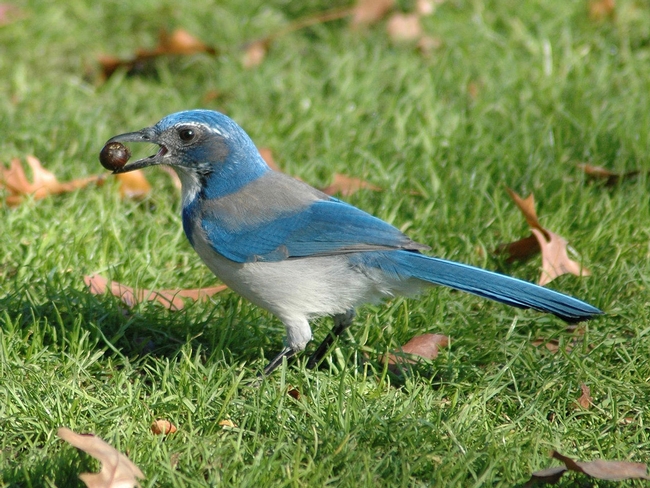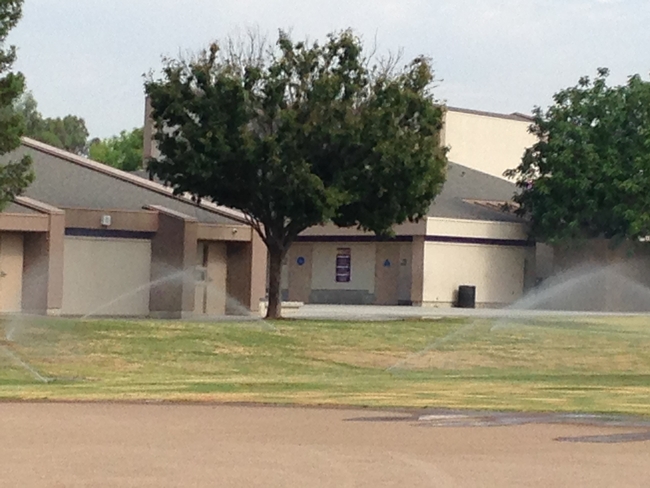Posts Tagged: Don Hodel
Living lawns keep yards cooler
Three UC Agriculture and Natural Resources researchers in Southern California have raised concerns about the trend in California to remove lawns to cope with the drought, reported Janet Zimmerman in the Riverside Press-Enterprise.
They believe living lawns need not be sacrificed to meet mandatory water-conservation goals set by Gov. Jerry Brown. Turf simply needs to be managed better, said Dennis Pittenger, UC ANR Cooperative Extension advisor based at UC Riverside. Pittenger co-wrote a white paper with UC ANR Cooperative Extension advisor Don Hodel in which they contend the push to remove grass is a knee-jerk reaction to the drought, the article said.
Pittenger provided five ways to reduce the amount of water needed for grass maintenance:
- Switching from fescue and other cool-season grasses to warm-season varieties such as Bermuda and St. Augustine, which go dormant in the winter. Warm-season grasses use 20 percent less water, when irrigated properly, than cool-season varieties.
- Ensuring sprinklers are working correctly, with overlap and good distribution.
- Using the appropriate amount of water. Lawns can survive on much less water than most people give them.
- Reducing or stopping fertilizer use, which prompts growth and increases water demands.
- Raising the mowing height to at least 3 inches to encourage grass to develop deeper roots.
“Do all those things before you consider taking out turf,” Pittenger said. “That will save quite a bit of water and maybe enough to get the savings necessary to meet goals.”
Jim Baird, UC ANR Cooperative Extension turfgrass specialist based at UC Riverside, said grass' contribution to increased property values and psychological well-being cannot be overstated, and it can be maintained with little water. Both Pittenger and Baird told the reporter they maintain living lawns at their own homes with minimal irrigation.
In an article on The Confluence blog, a team of UC ANR academics outlined "Practical advice on drought-tolerant landscaping in California."
They wrote that, "Trading in your turf for concrete, rock, or artificial turf are options. However, none of these selections promote healthy soils and other ecosystem services. In fact, all of these options can be problematic because they create a heat island effect and may have water infiltration or runoff issues."
Adapting to drought by removing urban landscapes has unintended impacts
Removing landscaping in urban areas to adapt to the California drought carries a gamut of potential repercussions on wildlife and the environment, reported LA Weekly. Two of Gov. Brown's water conservation rules - withholding water from grassy road medians and encouraging residents to remove their lawns - are taking an unexpected toll.
The subject was raised recently by two University of California Agriculture and Natural Resources (UC ANR) experts in a position paper they published on their website, the story said. Don Hodel, UC ANR Cooperative Extension advisor in LA County, and Dennis Pittenger, UC ANR Cooperative Extension area environmental horticulturist at UC Riverside, said landscapes and turf offer tremendous benefits to residents, communities and the environment.
"Nobody thought this out," Hodel said.
The LA Weekly article also quoted Loren Oki, the UC ANR Cooperative Extension specialist for landscape horticulture based at UC Davis. Among the obvious problems created by California's turf-removal program, Oki said, is "encouraging people to plant during the heat of the summer, which is the worst time" for new plants to survive in the ground. He predicts many of the low-water plants will not survive the late-summer heat.
Another UC Davis scientist, biochemistry professor William Horwath, raised the potential for turf removal to kill the "decomposition community" that lives in soil.
When cities and homeowners remove vegetation from land, that diminishes the diversity of the soil biology, especially the larger fauna such as worms, which feed off of the droppings of leaves and other materials from plants.
"If you are not growing anything, just gravel or mulch, you'll be losing a lot of worms, and you will at the same time be losing a lot of carbon from under the soil back into the atmosphere," Horwath said.
Oki was one of the authors of a recent post on the UC ANR California Institute for Water Resources blog, The Confluence, that provides practical, well-thought-out advice on drought-tolerant landscaping in California.
"A variety of options exist for gardeners implementing landscaping changes," the article says. "Trading in your turf for concrete, rock, or artificial turf are options. However, none of these selections promote healthy soils and other ecosystem services. In fact, all of these options can be problematic because they create a heat island effect and may have water infiltration or runoff issues."
The story details seven strategies for conserving water while maintaining a living landscape.
Drought concerns causing unnecessary impact on landscapes and lawns
“Landscape plants and the water they use are under unrelenting attack,” says Don Hodel, UC ANR Cooperative Extension advisor in Los Angeles County. “But most of these attacks are misguided when one looks at the facts.”
Hodel and Dennis Pittenger, UC ANR Cooperative Extension area environmental horticulturist in the Department of Botany and Plant Sciences at UC Riverside, wrote a six-page commentary, 9%: The California Drought and Landscape Water Use, with facts about the relatively small amount of California's water that goes into landscapes, and the tremendous benefits to residents, communities and the environment provided by these plants. The article was published in PalmArbor, an electronic journal for the green industry.
“Landscape water use in California accounts for only 9 percent of total statewide water use,” the authors wrote. “Yes, that's right, just 9 percent. If we never watered another home or public landscape, park, sports field, or golf course in California, the state would save 9 percent of its total water consumption.”
Pittenger and Hodel named 12 ways lawns and landscape plants enhance the quality of Californians' lives and make urban areas more livable. Trees, shrubs, groundcovers, lawns and flowers provide:
- Oxygen
- Carbon sequestration to help mitigate global warming
- Rain capture, dust and erosion control
- Shade and energy savings in heating and cooling
- Wildlife habitat
- Food
- Beauty and ornament
- Recreation
- Enhanced property values
- Psychological well-being
- Cultural/historic value
- Jobs and economic value
The authors assert that California cannot conserve its way out of drought by trying to wring out significant water savings from the 9 percent that keeps landscapes alive.
Instead of shutting off the sprinklers, the authors call for “judicious irrigation,” providing just enough water to trees, plants and lawns to keep them alive. The authors believe judicious irrigation may be sufficient by itself to meet the 25 to 35 percent water reductions required by the state without changing the landscape to so-called “low-water use” or “drought-tolerant” plants.
“Most woody plants are actually drought-tolerant and low-water use once they are established and cared for properly,” the article says. “Research over the last 30 years has shown that water-reduction goals can be met while maintaining the quality-of-life benefits that landscape plants and functional lawns provide.”
Hodel and Pittenger also identified three urban water uses that should be considered priorities for outdoor irrigation, even in times of extreme water scarcity.
- Public parks, school play grounds and sports fields. “Children need to play and exercise on grass, not asphalt or dirt,” the article says. “And we all benefit from walking and exercising in a green, pastoral setting.”
- Bona fide botanical gardens and arboreta. “These research collections of plants have immense value,” the authors wrote. “For example, the plant collections at the world-famous San Diego Zoo actually have greater value than the animals.”
- Trees. “Mature trees are among the most valuable and difficult-to-replace plants in urban areas,” the UC ANR experts said. “Their loss would be devastating.
The director of UC ANR's California Institute for Water Resources, Doug Parker, is a spokesperson for the University of California on water issues of statewide importance. He agrees that, in much of the state, urban communities benefit from natural plantings and turf should be a priority for recreation areas.
“It's true that rock gardens, artificial turf and hardscape do not provide much wildlife habitat, carbon sequestration or environmental cooling,” he said. “But in places like Palm Springs, they are appropriate.”
Having worked closely with policymakers, scientists, government organizations and consumers during the past four years of drought, Parker said he has reached the conclusion that Californians cannot build or conserve their way out of periodic droughts.
“What we really need is a change in mindset to learn to live with drought and uncertainty,” Parker said.
Following are free water-conservation publications from UC ANR:
Water conservation tips for the home lawn and garden
By Pamela Geisel, UC ANR Cooperative Extension advisor emeritus
Carolyn Unruh, staff writer
Managing turfgrasses during drought
By Ali Harvandi, UC ANR Cooperative Extension advisor emeritus
Jaimes Baird, UC ANR Cooperative Extension turfgrass specialist, UC Riverside
Janet Hartin, UC ANR Cooperative Extension environmental horticulture advisor, San Bernardino County




